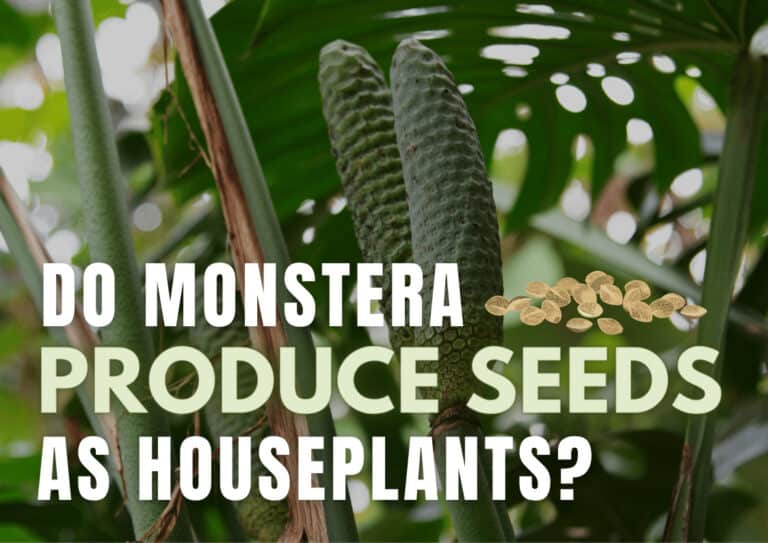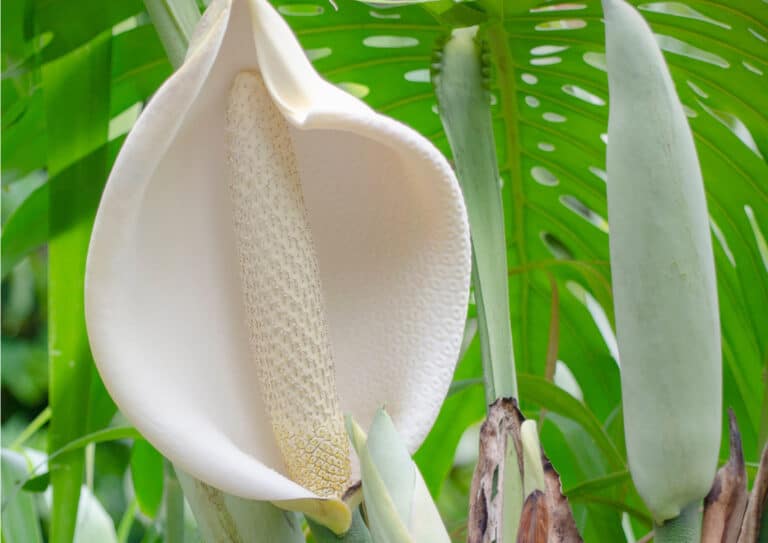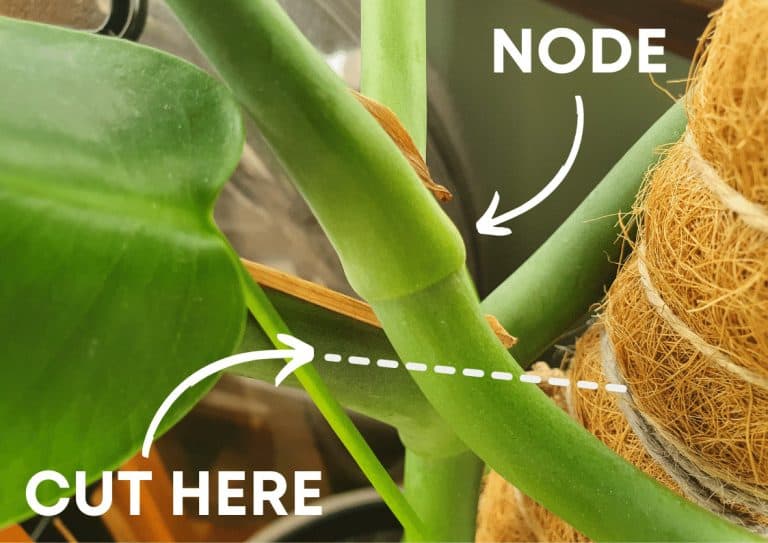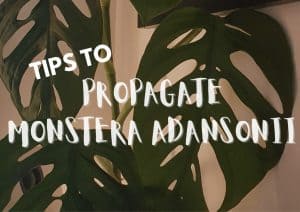Do Monstera Produce Seeds As Houseplants? Unveiling The Truth
- Chris Dosser with the assistance of A.I. technology
- March 27, 2023
If you buy something using the retail links in our articles, sometimes we earn a small affiliate commission. This does not impact the products we recommend.
Plants of the Monstera genus are incredibly popular houseplants due to their stunning foliage and ability to thrive across a range of indoor environments. Yet despite their omnipresence one frequently asked question about these plants keeps cropping up amongst owners. That being whether Monstera species can produce seeds while being grown as houseplants.
To put it bluntly, it is possible for Monstera plants to produce seeds whilst kept as houseplants, however it’s a rare occurrence as indoor conditions are not conducive to successful flowering and fruiting.
That being said, many opt to bypass the fruiting process and buy in fresh Monstera seeds to grow at home (fresh seeds have the highest chance of success).

Monstera reproduction
Natural habitat
Plants such as Monstera deliciosa, are primarily found in tropical rainforests. In their natural habitat, these plants produce seeds by flowering and developing fruits which upon ripening release seeds, which then fall to the ground or are dispersed by animals before beginning the germination process.
As houseplants
When grown as houseplants, Monstera plants are less likely to produce seeds. This is because the indoor environment usually doesn’t provide the same conditions as their native habitat, making it difficult for them to produce flowers and, subsequently, seeds.
As an example the pollination of Monstera deliciosa in the wild is facilitated by invertebrates such as Trigona bees, which if absent from the indoor environment mean the tricky process of hand-pollination must be carried out by the plant owner.
It’s important to note that some varieties, such as Monstera albo, are even less likely to produce seeds in an indoor environment owing to the variegated foliage generating less energy in the absence of optimal exposure to natural sunlight.

Do Monstera produce seeds as houseplants?
Monstera plants can produce seeds even when they are grown as houseplants, but it is relatively rare for this to happen.
One reason for this rarity is that Monstera plants need to produce flowers before they can develop seeds, and flowering is less common in indoor conditions. Monstera plants kept outdoors in a tropical clime, however, have a higher likelihood of flowering when they receive care that mimic’s their natural habitat.
To increase the chances of your indoor Monstera plant fruiting, you must ensuring that your plant receives as much bright, indirect sunlight as possible whilst maintaining an optimum temperature range of 65-85°F (18-29°C), and providing high humidity levels. It is helpful to maintain a consistent watering schedule and use well-draining soil with a suitable mix of organic matter.
Our Favorite Monstera Plants And Supplies On Etsy
Challenges of Monstera seed production
While Monstera plants are generally known for their ornamental qualities as houseplants, producing seeds comes with several challenges which we’ll discuss in this section…
Pollination
One of the primary challenges of producing seeds in Monstera plants is pollination. In their natural habitat, these plants rely on specialized insects for pollination, which are likely absent from a typical indoor environment. Achieving successful pollination indoors can be quite difficult without the aid of these natural pollinators. Artificial pollination is an option but it requires knowledge and skill to carry out successfully.
Seed maturity
Another challenge faced by Monstera plants when it comes to seed production is seed maturity. Monstera seeds must be fully mature before they can be harvested. Ensuring the seeds have reached an appropriate maturity when you’ve already been waiting an age can be a difficult exercise in discipline, especially for inexperienced growers. Monstera fruit can take up to 14 months to ripen!
Environmental factors
Lastly, environmental factors play a significant role in the success of seed production in Monstera plants. Maintaining optimal environmental conditions, such as temperature, humidity, and light, is crucial for successful seed germination and plant growth.
According to Bloom Sprouts, it takes at least 10 days for Monstera seeds to germinate, with visible sprouting occurring only under the right conditions. Ensuring that the right balance of conditions are consistently met indoor can be challenging, even for seasoned plant enthusiasts.
Alternative propagation methods
Stem cuttings
To circumnavigate around the challenges that fruit and seeds present, one of the most popular methods for propagating Monstera is through stem cuttings. This process involves taking a healthy section of the plant’s stem, usually below a node, and placing it in water or soil to stimulate root growth.
Although water propagation is more commonly used for its simplicity, both methods yield successful results when proper care is provided. After a few weeks, new roots will start to form and the cutting can be transferred to its own pot, creating a new plant.

Air layering
Air layering is a propagation method that encourages root growth on the parent plant before cutting and repotting. This approach involves making a small incision on the stem and adding sphagnum moss or a rooting hormone to stimulate root growth in the affected area. The incision is then wrapped with plastic wrap or foil to maintain moisture and encourage the formation of new roots. Once roots are developed, the stem can be cut and repotted as a new plant.
Learn more about air layering from The Houseplant Fairy.
Division method
Another way to propagate Monstera deliciosa is through the division method. In this approach, the parent plant is carefully removed from its pot, and the root ball is separated into smaller sections.
Each section should have a healthy root system and a few leaves to ensure successful growth. After dividing the root ball, the sections are repotted into separate containers and provided with proper care to establish themselves as independent plants.
Find out more about the division method on Mod and Mint.
Take home message
Monstera plants, when grown as houseplants, may not produce seeds as regularly as they would in their natural habitat. This is due to the lack of optimal pollination conditions and their unique reproductive process that involves a specific pollinator in their native environment.
In any case, if you wish to try growing Monstera plants from seed, ensure that you follow proper care guidelines for germination, soil, light, and humidity requirements to cultivate these beautiful and unique houseplants.
Similar Posts
Winterizing Your Monstera: Protecting Your Plant from Cold Damage
Monstera kept in chilly climates are susceptible to cold damage if not protected from the deep freeze. Here's some tips to winterize your precious fenestrated foliage.
Propagating Monstera Adansonii: Tips And Tricks For Success
There are two methods of propagating Monstera Adansonii - in soil and in water - and we're going to help run you through the process of each.



